Effect of Graphene Coating on the Heat Transfer Performance of a Composite Anti-/Deicing Component
Abstract
:1. Introduction
2. Experimental Procedure
2.1. Materials
2.2. Characterization
2.3. Preparation of Graphene Coating Samples
2.4. Preparation of Anti-/Deicing Component
2.5. Anti-/Deicing Component Heating and Deicing Experiments
3. Results and Discussion
3.1. Graphene Coating Characterizations
3.2. Anti-Icing Property
3.3. Deicing Property
3.4. Spraying Process
4. Conclusions
Acknowledgments
Author Contributions
Conflicts of interest
Nomenclature
| d | Width of the single-layer graphene, mm |
| L | Distance between the middle part of the single-layer graphene and the fins, mm |
| mice | Mass of the icing, kg |
| r | Radius of gyration, m |
| R | Resistance value, Ω |
| t | Heating time, s |
| Q | Joule heat energy, J |
| U | Heating voltage, V |
| v | Rotating linear velocity of the icing, m/s |
| Xg | Temperature coefficient |
| λ | Thermal conductivity, W/(m·°C) |
| δf | Change of G peak displacement |
| δP | Change of thermal power |
References
- Coffman, H.J. Helicopter rotor icing protection methods. J. Am. Helicopter Soc. 1987, 32, 34–39. [Google Scholar] [CrossRef]
- Zhang, X.; Wu, X.; Min, J. Aircraft icing model considering both rime ice property variability and runback water effect. Int. J. Heat Mass Transf. 2017, 104, 510–516. [Google Scholar] [CrossRef]
- Zhao, G.Q.; Zhao, Q.J.; Chen, X. New 3-D ice accretion method of hovering rotor including effects of centrifugal force. Aerosp. Sci. Technol. 2016, 48, 122–130. [Google Scholar] [CrossRef]
- Lee, J.S.; Yoon, J.C.; Jang, J.H. A route towards superhydrophobic graphene surfaces: Surface-treated reduced graphene oxide spheres. J. Mater. Chem. A 2013, 1, 7312–7315. [Google Scholar] [CrossRef]
- Zhu, X.; Zhang, Z.; Ge, B. Fabrication of a superhydrophobic carbon nanotube coating with good reusability and easy repair ability. Colloids Surface A 2014, 444, 252–256. [Google Scholar] [CrossRef]
- Farhadi, S.; Farzaneh, M.; Kulinich, S.A. Anti-icing performance of superhydrophobic surfaces. Appl. Surf. Sci. 2011, 257, 6264–6269. [Google Scholar] [CrossRef]
- Wang, Z.J.; Kwon, D.J.; Devries, K.L.; Park, J.M. Frost formation and anti-icing performance of a hydrophobic coating on aluminum. Exp. Therm. Fluid Sci. 2015, 60, 132–137. [Google Scholar] [CrossRef]
- Moaven, K.; Rad, M.; Taeibi-Rahni, M. Experimental investigation of viscous drag reduction of superhydrophobic nano-coating in laminar and turbulent flows. Exp. Therm. Fluid Sci. 2013, 51, 239–243. [Google Scholar] [CrossRef]
- Liu, Q.; Yang, Y.; Huang, M.; Zhou, Y.X.; Liu, Y.Y.; Liang, X.D. Durability of a lubricant-infused electrospray silicon rubber surface as an anti-icing coating. Appl. Surf. Sci. 2015, 346, 68–76. [Google Scholar] [CrossRef]
- Choi, B.G.; Park, H.S. Superhydrophobic graphene/nafion nanohybrid films with hierarchical roughness. J. Phys. Chem. C 2012, 116, 3207–3211. [Google Scholar] [CrossRef]
- Buschhorn, S.T.; Kessler, S.S.; Lachmann, N.; Gavin, J.; Wardle, B.L.; Thomas, G. Electrothermal icing protection of aerosurfaces using conductive polymer nanocomposites. In Proceedings of the 54th AIAA Structures, Structural Dynamics, and Materials (SDM) Conference, Boston, MA, USA, 2013; pp. 1–8. [Google Scholar]
- Nagappan, S.; Park, S.S.; Ha, C.S. Recent advances in superhydrophobic nanomaterials and nanoscale systems. J. Nanosci. Nanotechnol. 2014, 14, 1441–1443. [Google Scholar] [CrossRef] [PubMed]
- Bu, X.Q.; Lin, G.P.; Yu, J.; Song, X. Numerical simulation of an airfoil electrothermal anti-icing system. Proc. Inst. Mech. Eng. Part G J. Aerosp. Eng. 2013, 227, 1608–1622. [Google Scholar] [CrossRef]
- Pourbagian, M.; Habashi, W.G. Surrogate-based optimization of electrothermal wing anti-icing systems. J. Aircr. 2013, 50, 1555–1563. [Google Scholar] [CrossRef]
- Ding, L.; Chang, S.; Leng, M. Transient characteristics of an electrothermal anti-icing process based on the improved messinger model. In Proceedings of the 2016 IEEE International Conference on Aircraft Utility Systems (AUS), Beijing, China, 10–12 October 2016; pp. 233–238. [Google Scholar]
- Thomas, S.K.; Cassoni, R.P.; Macarthur, C.D. Aircraft anti-icing and de-icing techniques and modeling. J. Aircr. 2012, 33, 841–854. [Google Scholar] [CrossRef]
- Yin, C.B.; Zhang, Z.D.; Wang, Z.J.; Guo, H. Numerical simulation and experimental validation of ultrasonic de-icing system for wind turbine blade. Appl. Acoust. 2016, 114, 19–26. [Google Scholar] [CrossRef]
- Sandorff, P.E. Beam balancer electro-impulse deicing systems. U.S. Patent 4,501,398, 26 February 1985. [Google Scholar]
- Bernhart, W.D.; Schrag, R.L. Electroimpulse deicing—Electrodynamic solution by discrete elements. J. Aircr. 2012, 26, 547–553. [Google Scholar] [CrossRef]
- Tan, Y.W.; Zhang, Y.; Bolotin, K.; Zhao, Y. Measurement of scattering rate and minimum conductivity in graphene. Phys. Rev. Lett. 2007, 99, 246803. [Google Scholar] [CrossRef] [PubMed]
- Kim, H.; Miura, Y.; Macosko, C.W. Graphene/polyurethane nanocomposites for improved gas barrier and electrical conductivity. Chem. Mater. 2010, 22, 3441–3450. [Google Scholar] [CrossRef]
- Esfahani, M.R.; Languri, E.M. Exergy analysis of a shell-and-tube heat exchanger using graphene oxide nanofluids. Exp. Therm. Fluid Sci. 2016, 83, 100–106. [Google Scholar] [CrossRef]
- Tian, L.M.; Wang, Y.J.; Li, Z.Y.; Mei, H.R.; Shang, Y.G. The thermal conductivity-dependant drag reduction mechanism of water droplets controlled by graphene/silicone rubber composites. Exp. Therm. Fluid Sci. 2017, 85, 363–369. [Google Scholar] [CrossRef]
- Jang, S.; Jang, H.; Lee, Y.; Sub, D.; Baik, S.; Hong, B.H.; Ahn, J.H. Flexible, transparent single-walled carbon nanotube transistors with graphene electrodes. Nanotechnology 2010, 21, 425201. [Google Scholar] [CrossRef] [PubMed]
- Kang, J.; Kim, H.; Kim, K.S.; Lee, S.K.; Bae, S.; Ahn, J.H.; Kim, Y.J.; Choi, J.B.; Hong, B.H. High-performance graphene-based transparent flexible heaters. Nano Lett. 2011, 11, 5154. [Google Scholar] [CrossRef] [PubMed]
- Yu, D.; Dai, L. Self-assembled graphene/carbon nanotube hybrid films for super capacitors. J. Phys. Chem. Lett. 2015, 1, 467–470. [Google Scholar] [CrossRef]
- Zhu, Y.; Murali, S.; Stoller, M.D.; Ganesh, K.J.; Cai, W.W.; Ferreira, P.J.; Pirkle, A.; Wallace, R.M.; Cychosz, K.A.; Thommes, M.; et al. Carbon-based supercapacitors produced by activation of graphene. Science 2011, 332, 1537–1541. [Google Scholar] [CrossRef] [PubMed]
- Kamyshny, A.; Magdassi, S. Conductive nanomaterials for printed electronics. Small 2014, 10, 3515. [Google Scholar] [CrossRef] [PubMed]
- Secor, E.B.; Ahn, B.Y.; Gao, T.Z.; Lewis, J.A.; Hersam, M.C. Rapid and versatile photonic annealing of graphene inks for flexible printed electronics. Adv. Mater. 2015, 27, 6683. [Google Scholar] [CrossRef] [PubMed]
- Lu, F.; Botte, G.G. Ammonia generation via a graphene-coated nickel catalyst. Coatings 2017, 7, 72. [Google Scholar]
- Chen, J.Z.; Chiu, Y.F.; Chen, C.W.; Hsu, C.C.; Cheng, I.C. Atmospheric-pressure plasma jet processed Pt-decorated reduced graphene oxides for counter-electrodes of dye-sensitized solar cells. Coatings 2016, 6, 44. [Google Scholar]
- Volman, V.; Zhu, Y.; Raji, A.R.; Genorio, B.; Lu, W.; Xiang, C.; Kittrell, C.; Tour, J.M. Radio-frequency-transparent, electrically conductive graphene nanoribbon thin films as deicing heating layers. ACS Appl. Mater. Interfaces 2014, 6, 298–304. [Google Scholar] [CrossRef] [PubMed]
- Raji, A.R.; Varadhachary, T.; Nan, K.; Wang, T.; Lin, J.; Ji, Y.; Genorio, B.; Zhu, Y.; Kittrell, C.; Tour, J.M. Composites of graphene nanoribbon stacks and epoxy for joule heating and deicing of surfaces. ACS Appl. Mater. Interfaces 2016, 8, 3551–3556. [Google Scholar] [CrossRef] [PubMed]
- Wang, T.; Zheng, Y.; Raji, A.R.; Li, Y.; Sikkema, W.K.; Tour, J.M. Passive anti-icing and active deicing films. ACS Appl. Mater. Interfaces 2016, 8, 14169–14173. [Google Scholar] [CrossRef] [PubMed]
- Ellahi, R.; Shivanian, E.; Abbasbandy, S.; Hayat, T. Numerical study of magnetohydrodynamics generalized couette flow of eyring-powell fluid with heat transfer and slip condition. Int. J. Numer. Methods Heat 2016, 26, 1433–1445. [Google Scholar] [CrossRef]
- Rashidi, S.; Esfahani, J.A.; Ellahi, R. Convective heat transfer and particle motion in an obstructed duct with two side by side obstacles by means of DPM model. Appl. Sci. 2017, 7, 431. [Google Scholar] [CrossRef]
- Shirvan, K.M.; Mamourian, M.; Mirzakhanlari, S.; Ellahi, R. Two phase simulation and sensitivity analysis of effective parameters on combined heat transfer and pressure drop in a solar heat exchanger filled with nanofluid by RSM. J. Mol. Liq. 2016, 220, 888–901. [Google Scholar] [CrossRef]
- Shirvan, K.M.; Ellahi, R.; Mirzakhanlari, S.; Mamourian, M. Enhancement of heat transfer and heat exchanger effectiveness in a double pipe heat exchanger filled with porous media: Numerical simulation and sensitivity analysis of turbulent fluid flow. Appl. Therm. Eng. 2016, 109, 761–774. [Google Scholar] [CrossRef]
- Shirvan, K.M.; Mamourian, M.; Mirzakhanlari, S.; Ellahi, R.; Vafai, K. Numerical investigation and sensitivity analysis of effective parameters on combined heat transfer performance in a porous solar cavity receiver by response surface methodology. Int. J. Heat Mass Transf. 2017, 105, 811–825. [Google Scholar] [CrossRef]
- Bhatti, M.M.; Zeeshan, A.; Ellahi, R. Electromagnetohydrodynamic (EMHD) peristaltic flow of solid particles in a third-grade fluid with heat transfer. Mech. Ind. 2017, 18, 314. [Google Scholar] [CrossRef]
- Civil Aviation Administration of China; Miller, F.P.; Vandome, A.F.; McBrewster, J. (Eds.) Alphascript Publishing: Beau Bassin, Mauritius, 2010. [Google Scholar]
- Berger, C. Electronic confinement and coherence in patterned epitaxial graphene. Science 2006, 312, 1191. [Google Scholar] [CrossRef] [PubMed]
- Guo, Z.; Zhang, D.; Gong, X.G. Thermal conductivity of graphene nanoribbons. Appl. Phys. Lett. 2009, 95, 163103. [Google Scholar] [CrossRef]
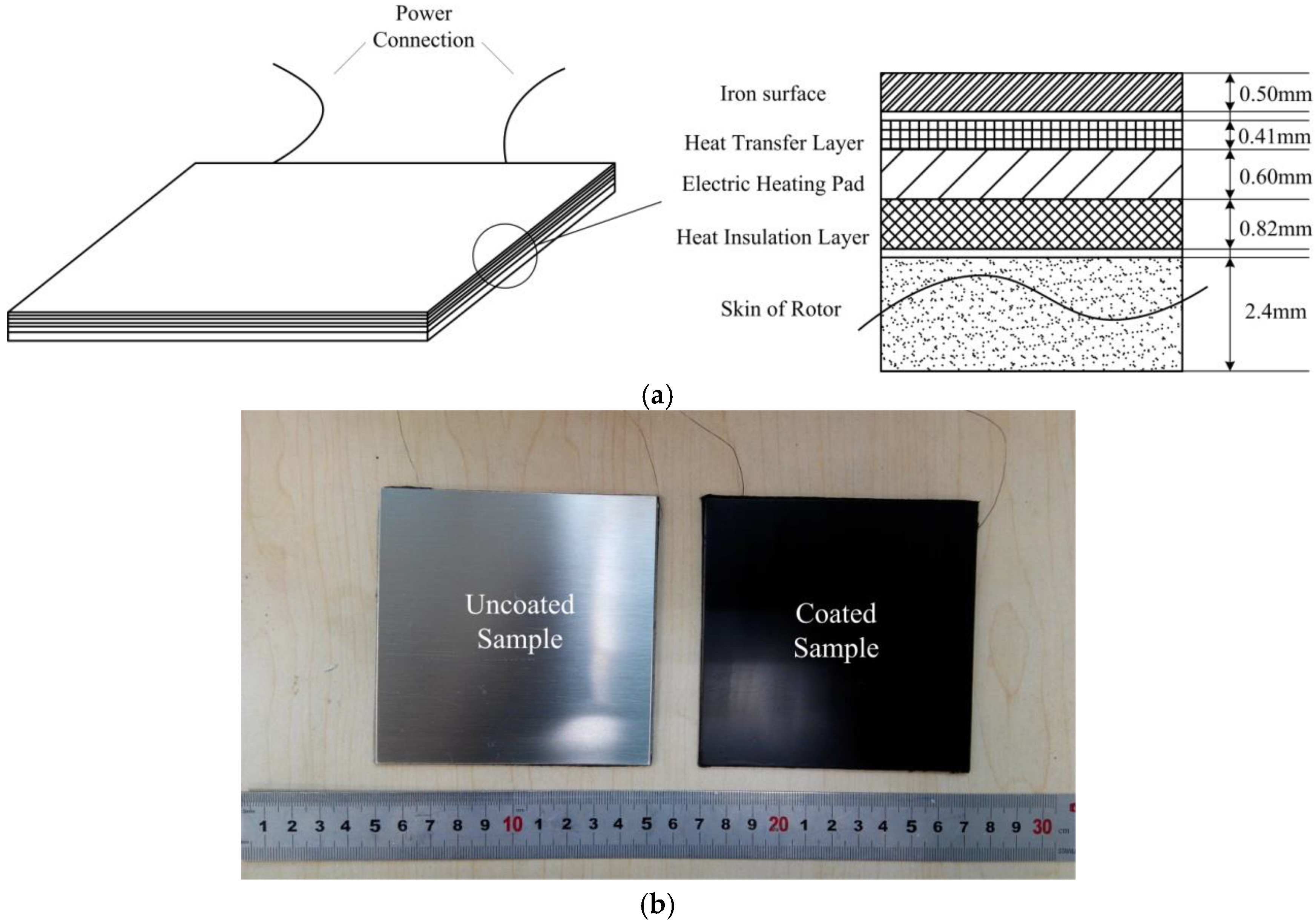


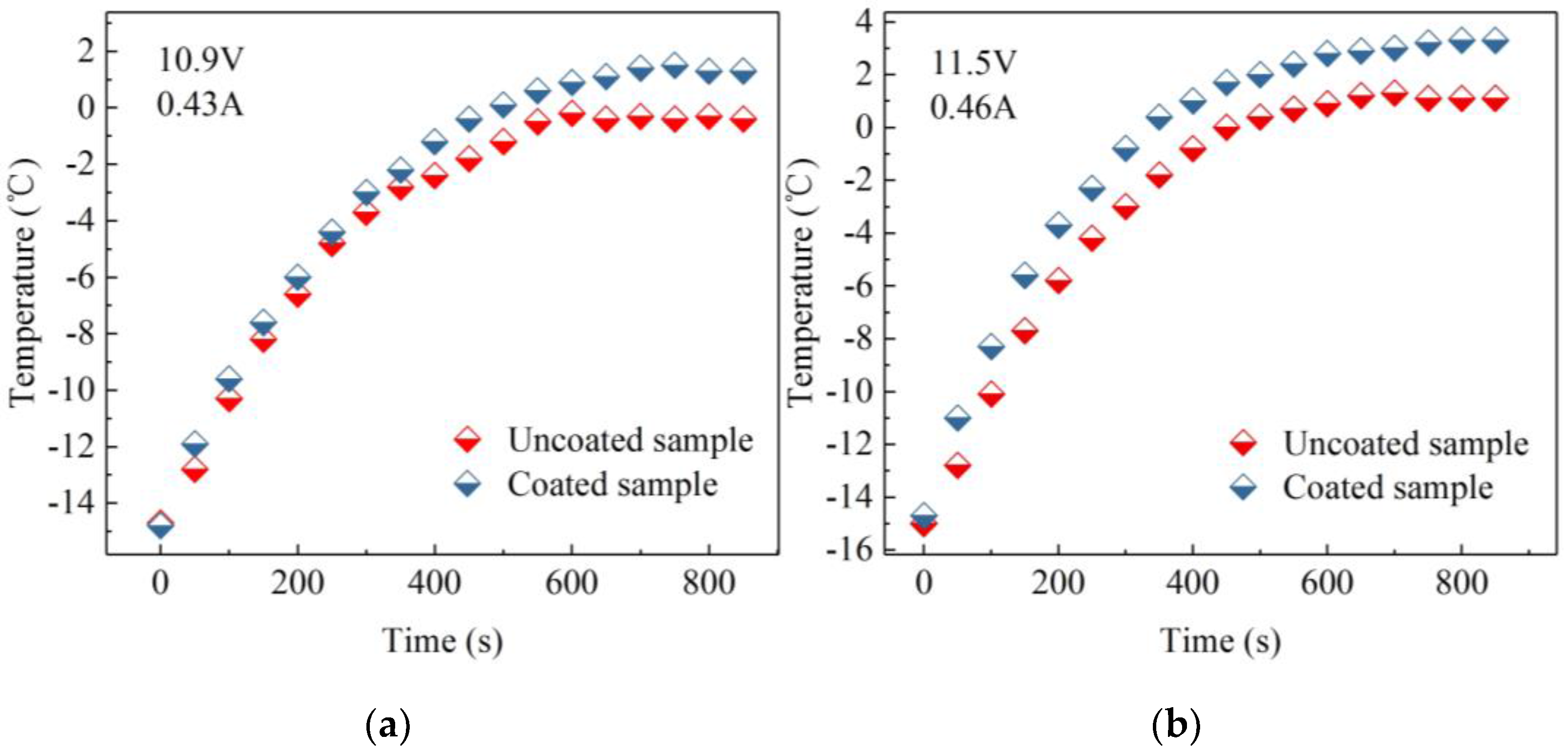
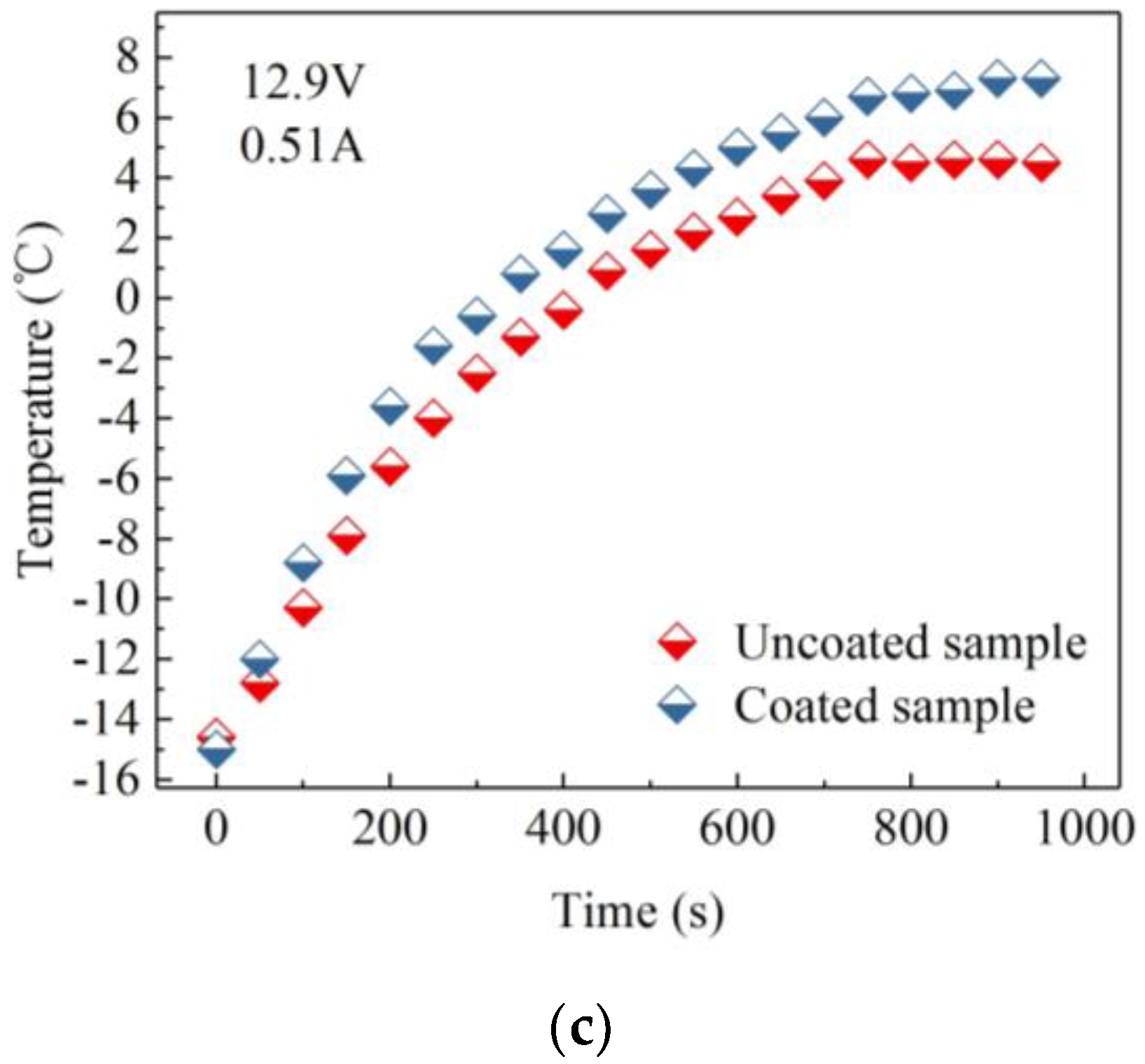
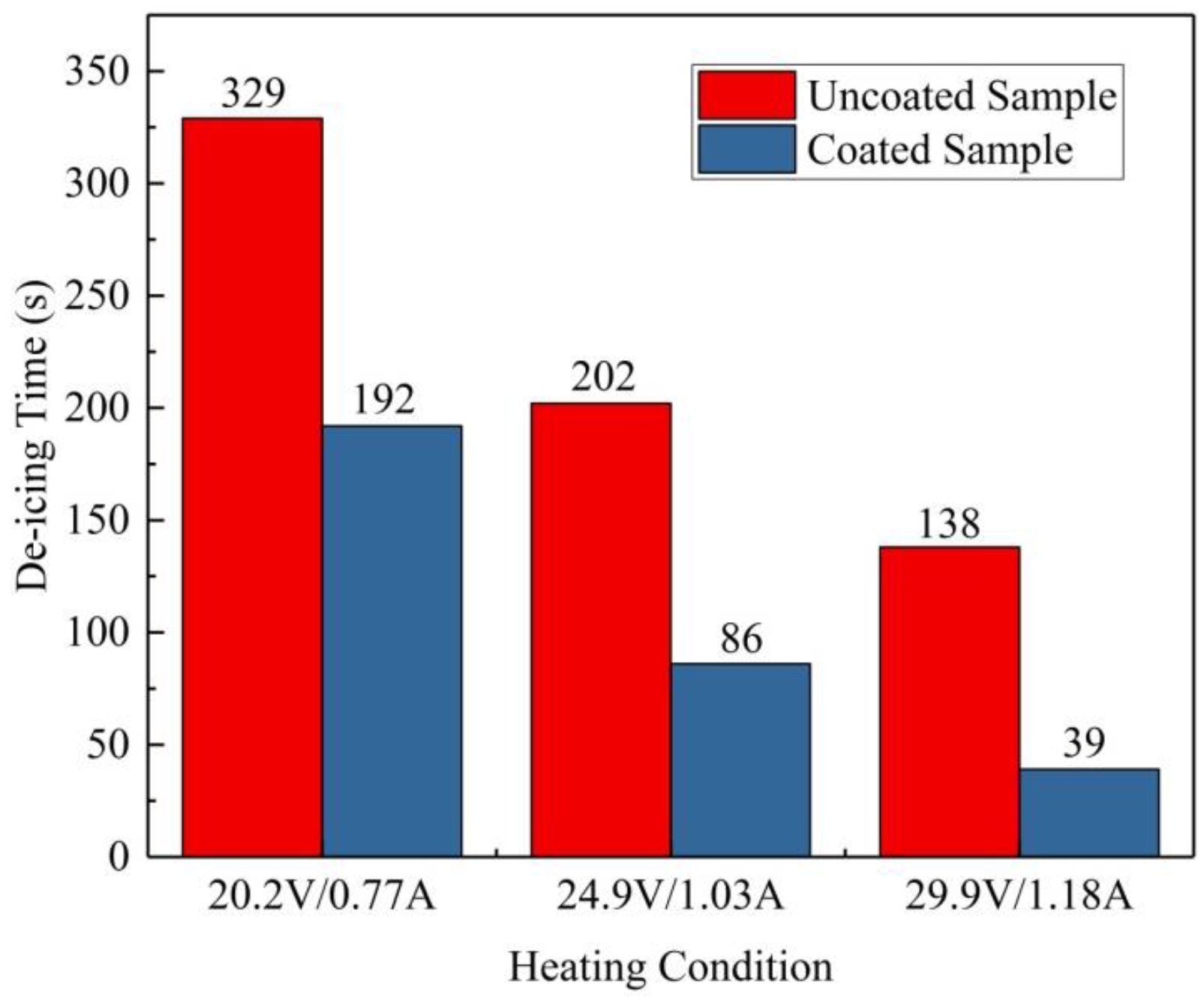

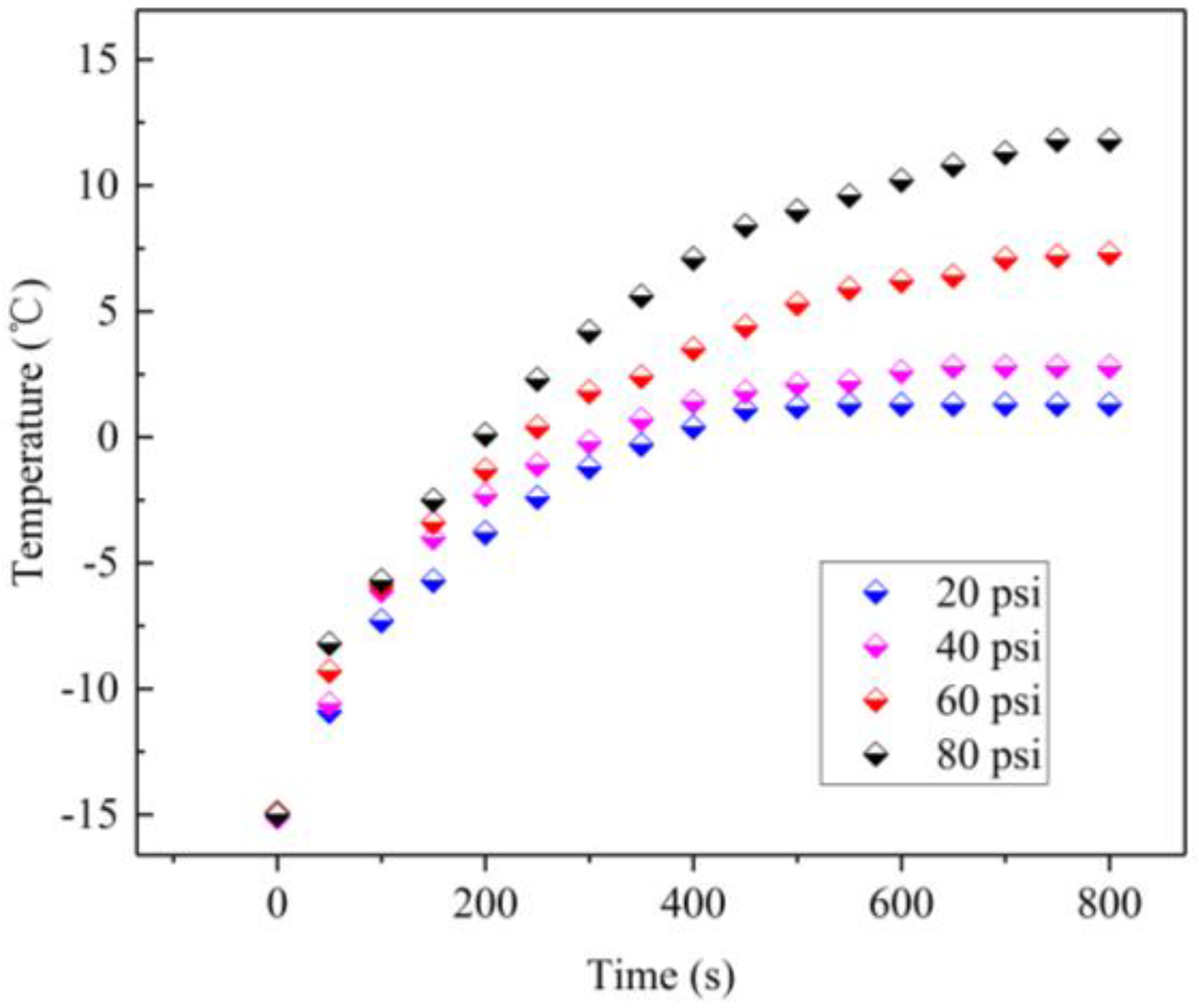
© 2017 by the authors. Licensee MDPI, Basel, Switzerland. This article is an open access article distributed under the terms and conditions of the Creative Commons Attribution (CC BY) license (http://creativecommons.org/licenses/by/4.0/).
Share and Cite
Chen, L.; Zhang, Y.; Wu, Q. Effect of Graphene Coating on the Heat Transfer Performance of a Composite Anti-/Deicing Component. Coatings 2017, 7, 158. https://doi.org/10.3390/coatings7100158
Chen L, Zhang Y, Wu Q. Effect of Graphene Coating on the Heat Transfer Performance of a Composite Anti-/Deicing Component. Coatings. 2017; 7(10):158. https://doi.org/10.3390/coatings7100158
Chicago/Turabian StyleChen, Long, Yidu Zhang, and Qiong Wu. 2017. "Effect of Graphene Coating on the Heat Transfer Performance of a Composite Anti-/Deicing Component" Coatings 7, no. 10: 158. https://doi.org/10.3390/coatings7100158




